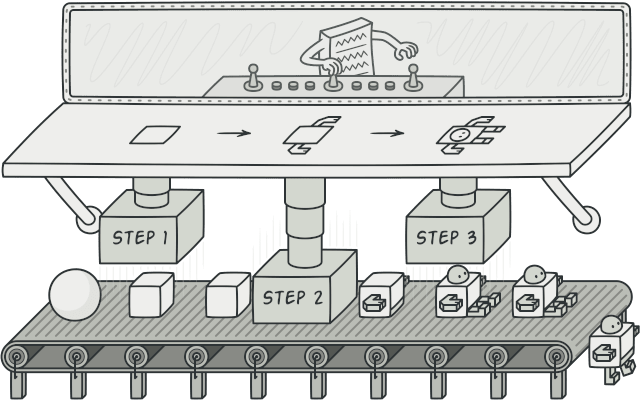这篇主要介绍 Pytorch 和 TensorFlow 的 Profiler 设计。二者均由 C++ 实现,因此可以利用 OO 特性以及一定的设计方法轻松实现 Profiler(如汇总 operator 的计算)。但其他 DL 框架可能由于并未如此实现而无法使用类似设计。
1. Pytorch Profiler 1 基于 Event 驱动。简单来说是在 forward 前后有两个 hook。
注:autograd 中的 profiler 是第一代,profiler 下的是第二代。
1 2 3 4 5 6 7 8 9 10 11 12 13 14 15 16 17 def __enter__ (self) : self._start_trace() return self def __exit__ (self, exc_type, exc_val, exc_tb) : records = _disable_profiler_legacy() parsed_results = _parse_legacy_records(records) self.function_events = EventList( parsed_results, use_cuda=self.use_cuda, profile_memory=self.profile_memory, with_flops=self.with_flops) self.function_events._build_tree() return False
_start_trace 又调用了 _enable_profiler_legacy,其与 _disable_profiler_legacy 都在 cpp 里面定义。在 torch/csrc/autograd/profiler_legacy.cpp 中定义了 enableProfilerLegacy 以及 disableProfilerLegacy。其中 disableProfilerLegacy:
1 2 3 4 5 thread_event_lists disableProfilerLegacy ( c10::optional<ProfilerDisableOptions> profilerDisableOptions) return state_ptr->consolidate(); }
thread_event_lists 存储了一个个事件(事件类型、事件发生时间、编号),会转化为 records。这个时候是没有做类似 Avg 之类的处理的。thread_event_lists 仅仅存储事件。
返回的 thread_event_lists 由 event_lists_map_ (unordered_map<uint64_t, RangeEventList>) 中的 event list 内的 events 与 remoteProfiledEvents_ 中的 events 两部分组成,不必多言。
前者 (RangeEventList) 通过 record 追加事件 evt。
不同的事件有不同的插入场合,例如 Memory 相关的在 Allocator,计算相关在 forward 处。
回到 py 层,可以在 class EventList 看到明显的打标输出:
1 2 3 4 5 6 7 8 9 10 11 12 13 14 15 16 17 18 19 20 21 22 23 class EventList (list) : """A list of Events (for pretty printing)""" def __init__ (self, *args, **kwargs) : def _build_table (events, sort_by=None, header=None, row_limit=100 , max_src_column_width=75 , max_name_column_width=55 , max_shapes_column_width=80 , with_flops=False, profile_memory=False, top_level_events_only=False) : """Prints a summary of events (which can be a list of FunctionEvent or FunctionEventAvg).""" def table (self, sort_by=None, row_limit=100 , max_src_column_width=75 , max_name_column_width=55 , max_shapes_column_width=80 , header=None, top_level_events_only=False) : return _build_table(self, sort_by=sort_by, row_limit=row_limit, max_src_column_width=max_src_column_width, max_name_column_width=max_name_column_width, max_shapes_column_width=max_shapes_column_width, header=header, profile_memory=self._profile_memory, with_flops=self._with_flops, top_level_events_only=top_level_events_only) def __str__ (self) : return self.table()
也就是 start 开启,exit 调用时把 cpp 侧的 event list 返回 py 侧,打表输出。
2. TensorFlow Profiler 2 同样基于 Event。这里给出一些在 TensorBoard 中看得到的指标。
1 2 3 4 5 6 7 8 9 10 11 12 static const auto * generic_event_type_str_map = new GenericEventTypeStrMap({ {kDeviceCompute, "Device compute" }, {kDeviceToDevice, "Device to device" }, {kDeviceCollectives, "Device collective communication" }, {kHostCompute, "Host compute" }, {kHostPrepare, "Kernel launch" }, {kInput, "Input" }, {kOutput, "Output" }, {kCompile, "Compilation" }, {kAllOthers, "All others" }, });
以上述 “Device to device” 为例,其对应的 kDeviceToDevice 类型为 GenericEventType,是 Profiler 展示给用户的事件类型之一,表示设备间通信时间。这段通信时间由 “真实通信时间” 与 “设备等待时间” 两部分组成。如下所示,CreatePodStatsRecord 中将 DEVICE_TO_DEVICE 与 DEVICE_WAIT_DEVICE 和 kDeviceToDevice 绑定。
1 2 3 4 5 6 7 8 9 10 11 12 13 14 15 16 17 18 19 20 21 22 23 24 25 26 27 28 29 30 31 32 33 34 35 36 37 PodStatsRecord CreatePodStatsRecord (absl::string_view host_name, const StepInfoResult& step_info) PodStatsRecord record; GenericStepBreakdown generic; bool success = step_info.step_breakdown().UnpackTo(&generic); DCHECK(success); record.set_host_name(string (host_name)); record.set_step_num(step_info.step_num()); record.set_total_duration_us(PicoToMicro(step_info.duration_ps())); auto & step_breakdown_map = *record.mutable_step_breakdown_us(); std ::vector <std ::pair<uint64, absl::string_view>> metrics; auto add_event = [&](GenericEventType type, std ::initializer_list <EventType> event_list) { uint64 ps = 0 ; for (const auto & event_type : event_list) { ps += gtl::FindWithDefault(generic.type_ps(), event_type, 0 ); } step_breakdown_map[type] = PicoToMicro(ps); metrics.emplace_back(ps, GetGenericEventTypeStr(type)); }; add_event(kDeviceCompute, {DEVICE_COMPUTE_32, DEVICE_COMPUTE_16}); add_event(kDeviceToDevice, {DEVICE_TO_DEVICE, DEVICE_WAIT_DEVICE}); add_event(kDeviceCollectives, {DEVICE_COLLECTIVES}); add_event(kHostCompute, {HOST_COMPUTE}); add_event(kHostPrepare, {HOST_PREPARE}); add_event(kInput, {HOST_WAIT_INPUT, HOST_TO_DEVICE, DEVICE_WAIT_HOST}); add_event(kOutput, {DEVICE_TO_HOST}); add_event(kCompile, {HOST_COMPILE}); add_event(kAllOthers, {UNKNOWN_TIME}); std ::sort(metrics.begin(), metrics.end()); record.set_bottleneck(metrics.back().second.data(), metrics.back().second.size()); return record; }
CreatePodStatsRecord 根据 StepInfoResult 输出 metrics 信息。
注:DEVICE_TO_DEVICE 同样是枚举值。
3. 总结 以正常人类大脑出发,Profiler 的实现要么是 “在关键操作前后插入代码”,要么是 “按照预定义规则监控系统”。抛开后者不谈(因为上面没谈这个),前者又可分为静态和动态。对于 pytorch 和 tensorflow 这种自研 profiler,他们的开发者可以轻松获得源代码并在其上进行修改,并且还可以保证代码快速合入,我猜测或许也有这方面考虑。而对于接触源码难度较高的外部开发者,在不借助社区的前提下开发 profiler 更好的办法是 dynamic instrumentation。
但不排除语言本身或社区均无法提供相应支持。

